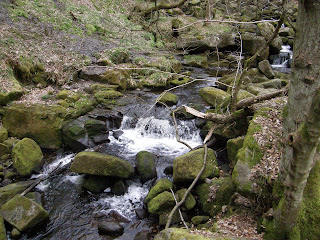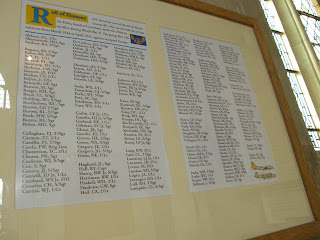 Part 2 - The Town
Part 2 - The TownIn the Medieval period Lavenham was one of the wealthiest towns in England, richer even than cities like Lincoln and York.This wealth all came from the production of woollen cloth especially the broadcloth known as Lavenham blue. The phrase 'dyed in the wool' originates from the practice of dying the wool before it was woven and Lavenham blue was the result of dyeing with
woad. In the early Middle Ages English wool was exported to Flanders and woven into cloth there then re-imported but in the 14th century Flemish weavers came to England and some settled in Lavenham and that is when things really took off. The famous Lavenham blue broadcloth was exported all over Europe.
The photo above is of the Guildhall of the Guild of Corpus Christi built in the 1520s and the only survivor of the four original Guildhalls in Lavenham. It was where the Merchant Clothiers met and governed every part of the local wool trade. When the Guilds were dissolved at the
Reformation the Guildhall became the Town Hall for the next 100 years and then had an even more chequered history as a prison, a workhouse, an almshouse and a wool store. In WW2 it housed evacuees and served as the 'Welcome Club' for members of the US Air Force stationed in and around Lavenham. Now it is run by the National Trust as a tea room and museum.

The Wool Hall is also a former Guild Hall but it was dismantled in 1911. It was eventually saved by a local clergyman and re-erected in its original position and now forms part of The Swan Inn. So I suppose that strictly speaking there are two surviving Guild Halls but because of all the messing about it doesn't quite count for me.

Attached to one end of the Guildhall next to the entrance to the present day tearooms is this rare example of an original Tudor shop. Goods would be traded through the two arched windows (which I suspect would have been unglazed at that time) and at night the wooden shutters would be closed to secure the shop. Both the bottom shutters are still there but only one remains at the top.

At the back of the Guildhall is a lovely, tranquil little Dye Garden which I had entirely to myself the day I was there. I suspect a lot of people don't even realise that it exists.

This board shows all the dye plants that are grown in the garden, it's a fascinating place.

The back of the Guildhall holds still more intriguing sights for those who explore - this is the 19th century parish lock-up.....

.....and the parish mortuary!

The increasing prosperity of the wool trade brought more and more people to Lavenham and almost all the timbered buildings in the town date from between 1450 and 1500. They are crammed in all over the place and are all shapes and sizes. This is the High Street which is the main road through Lavenham.

The Angel Inn was first licensed in 1420, the original inn has been added to over the centuries and the outside was plastered over in the 18th century.

Until the mid-18th Century there was a weekly market held in the Market Place and four times a year there was a fair which I imagine drew people from miles around and a jolly good time was had by all. This is the Market Cross put up in 1501 with money left by a local merchant called William Jacob. Behind it stands the market toll-keepers cottage all by itself in the middle of the square - it is now an Estate Agents!

Everywhere you look there are the most beautiful old buildings. I love this one, I think it's the de Vere house which presumably belonged to the de Vere family who were the local Lords of the Manor. Whoever had it built was certainly very wealthy as it has a brick infill done in a herringbone pattern rather than the usual wattle and daub.

In Lavenham we are not just talking about one or two ancient houses but streets and streets of them, it is known as the finest medieval town in England.

This is Water Street, 500 years ago the stream that still runs under here was culverted and the houses built over the top.

Finally this lovely weather vane with a beautiful
Suffolk Punch horse on it. The Suffolk Punches are wonderful, wonderful horses, huge, powerful and gentle and, sadly, an endangered breed now. Of all the heavy horse breeds these are my favourites.
Clicking on any of the photographs will enlarge them and some, like the de Vere house are worth looking at more closely. Lavenham is a fascinating place and well worth a visit if you ever get the chance. I certainly intend going again.


























































